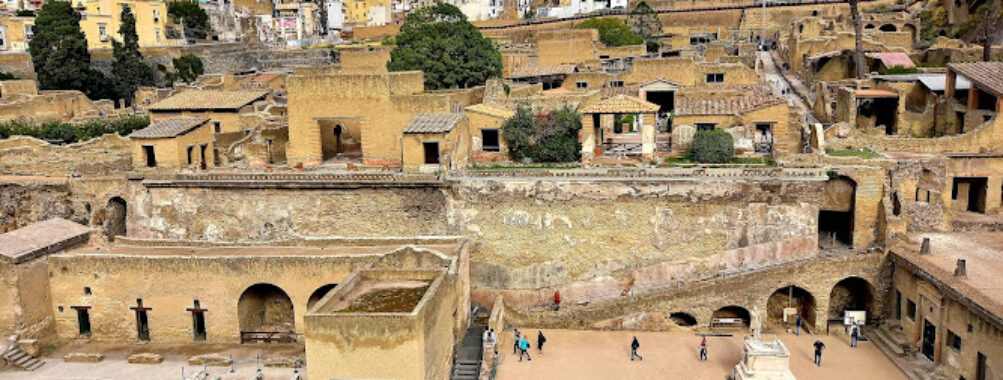
Archaeological Park of Herculaneum
Description
The Archaeological Park of Herculaneum stands as a remarkable testament to Roman civilization, frozen in time by the catastrophic eruption of Mount Vesuvius in 79 AD. Unlike its more famous neighbor Pompeii, Herculaneum offers visitors an incredibly well-preserved glimpse into daily Roman life, thanks to the unique way it was buried under volcanic material that actually helped preserve even organic materials like wooden furniture and food.
Key Features
• Ancient Roman Houses: The site showcases remarkably intact multi-story buildings, complete with original wooden beams and staircases – something you rarely see in archaeological sites this old. Many homes still feature their original frescos, mosaics, and even graffiti.
• The Thermal Baths: These public bathhouses reveal sophisticated Roman engineering, with separate sections for men and women, and intact heating systems that demonstrate advanced Roman technology.
• College of the Augustales: This imposing building, dedicated to the imperial cult, features some of the site’s most impressive architectural elements and decorative features.
• The Boat Houses: Perhaps the most poignant feature of Herculaneum, these arched chambers along the ancient shoreline contain the remains of residents who tragically sought shelter from the eruption.
• Villa of the Papyri: While mostly unexcavated, this massive villa has yielded hundreds of ancient scrolls, carbonized by the eruption but preserved in remarkable condition.
Best Time to Visit
Spring (April-May) and fall (September-October) offer the most pleasant conditions for exploring Herculaneum. During these months, temperatures hover around a comfortable 20°C (68°F), and crowds are noticeably thinner than during peak summer season. Early morning visits, particularly around opening time, provide the best lighting for photography and fewer tourists. Avoid visiting during the intense midday heat of summer months, when temperatures can soar above 35°C (95°F).
How to Get There
From Naples, your best bet is taking the Circumvesuviana train to the Ercolano Scavi station. The archaeological park sits about a 10-minute walk from the station – just follow the signs downhill toward the coast. If you’re driving, you’ll find paid parking lots near the entrance, though spaces can be limited during peak season. Several tour companies also offer guided day trips from Naples, Rome, and the Amalfi Coast, often combining Herculaneum with a visit to Mount Vesuvius or Pompeii.
Tips for Visiting
To make the most of your Herculaneum experience, grab an audio guide at the entrance – they’re worth every penny and really bring the ancient city to life. Wear comfortable shoes with good grip, as some of the ancient Roman streets can be slippery. Unlike Pompeii, Herculaneum is relatively compact and can be explored thoroughly in about 2-3 hours.
Pack plenty of water and sun protection – there’s limited shade within the archaeological park. Photography is allowed, but tripods require special permission. Getting there early helps beat both the crowds and the heat. The site can be quite exposed to the elements, so bring an umbrella for sun or rain depending on the season.
Consider booking your tickets online in advance to avoid queues, especially during peak tourist season. The site offers wheelchair accessibility, though some areas might be challenging due to the ancient terrain. Keep in mind that many of the best-preserved artifacts from Herculaneum are actually housed in the National Archaeological Museum in Naples – combining both visits gives you the most complete picture of life in ancient Rome.
If you’re interested in a deeper understanding, hiring a licensed guide can be incredibly worthwhile. They can explain details you might miss on your own and provide fascinating context about daily life in ancient Rome. Last but not least, don’t forget to check out the skeletal remains in the boat houses – they tell a powerful story about the human tragedy of the Vesuvius eruption.
Just remember, you’re walking through real history here – every stone has a story to tell. Take your time, look up at the details of the buildings, and try to imagine the bustling Roman town as it once was. And hey, if you get hungry, there are plenty of great local restaurants in modern Ercolano just a short walk from the archaeological park.
Table of Contents
Location
Places to Stay Near Archaeological Park of Herculaneum
Find and Book a Tour
Explore More Travel Guides
No reviews found! Be the first to review!